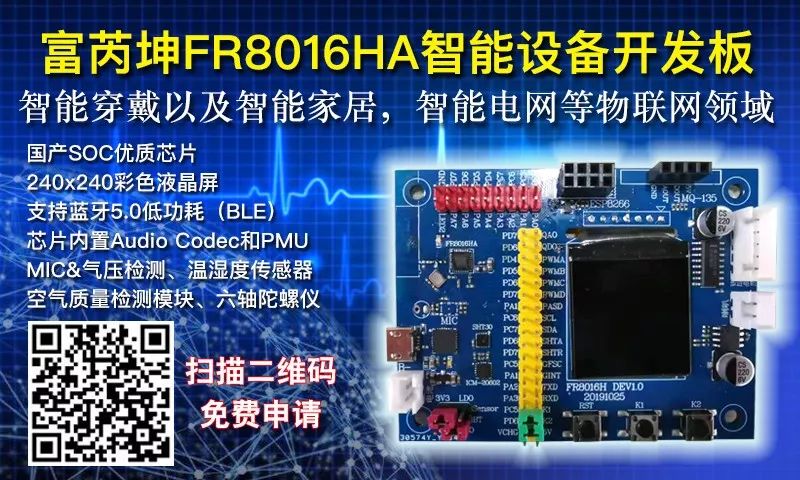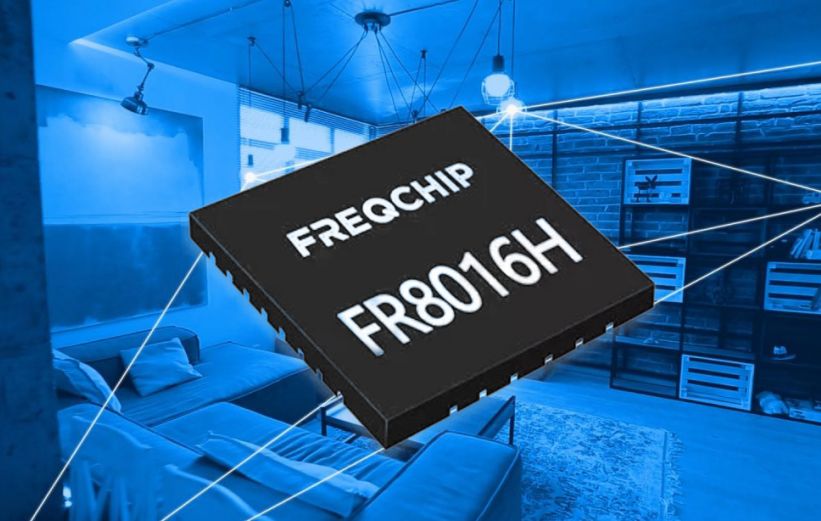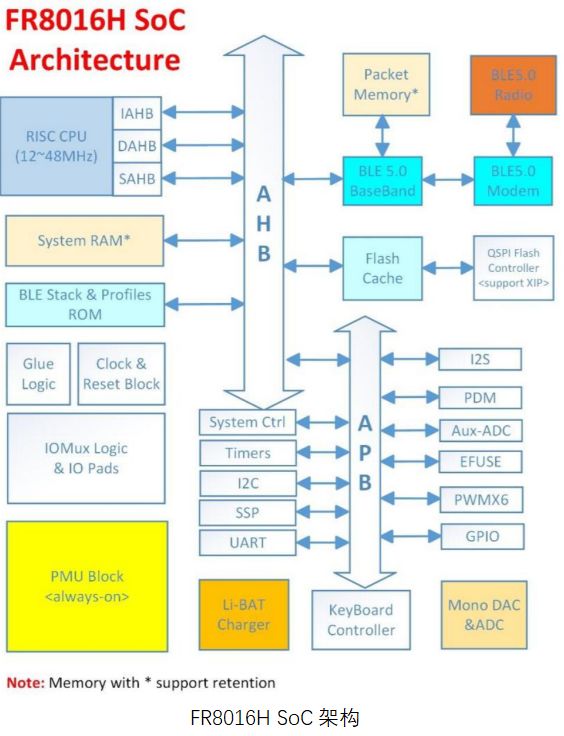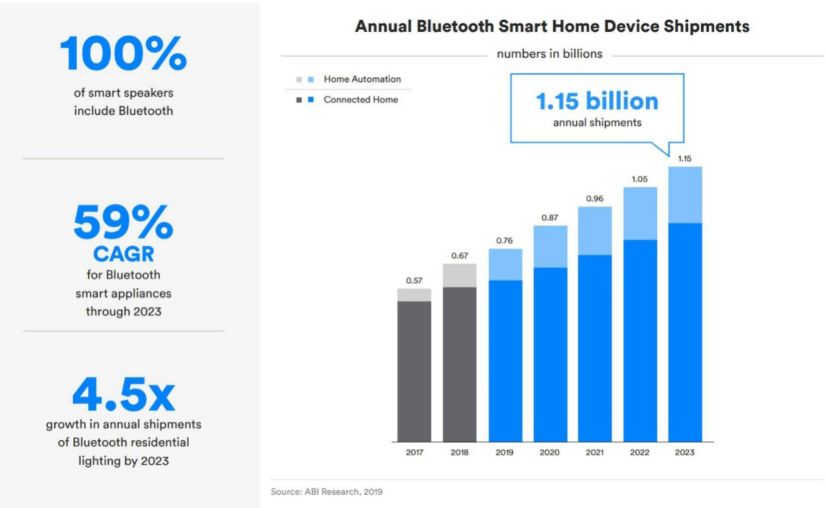In the past two years of trade frictions, there have been at least twenty rounds of back-and-forth between China and the United States. By May of this year, BIS (the U.S. Department of Commerce’s Bureau of Industry and Security) included Huawei and its 68 affiliates on the Entity List, continuing the ongoing dispute. China plans to increase its self-sufficiency in semiconductor products from 16% to 40% by 2020, and to 70% by 2025.[1]
From the market situation observable on the media side, more and more domestic chip manufacturers are willing to share details of their chip products with us—previously, these manufacturers had been relatively low-profile during their years of development. For example, we recently reported on a domestically developed automotive-grade MCU product.
Foreign chip manufacturers are also feeling the pressure under the current international trade backdrop. For example, in the field of wireless RF chips, Dialog’s latest DA14531 is a BLE (Bluetooth Low Energy) chip that has been priced down to $0.5, aiming to drive the next billion IoT devices[2]. This is clearly a response to the low-cost chips from domestic manufacturers; similar products in different fields are expected to emerge in greater numbers. In the Bluetooth chip sector, the response strategies of domestic manufacturers can be glimpsed from the product planning of Shanghai Frequen Microelectronics Co., Ltd.
Frequen shared with us some details about its FR8016H low-power Bluetooth SoC. The price of this chip is comparable to the aforementioned DA14531. According to Frequen’s Vice President, Niu Zhao, the FR8016H is “more features without a higher price,” integrating a PMU (Power Management Unit) and Audio CODEC while maintaining the same price level (or even slightly lower), mainly targeting applications in smart homes, wearable devices, and smart electric meters.
This opportunity allows us to further understand the current technological development level of domestic Bluetooth chip manufacturers in this relatively unique international environment, as well as their strategies and thoughts in responding to foreign giants.
A Shift in Competitive Thinking
Before formally discussing the FR8016H, let’s first look at the positioning of this product within Frequen’s existing product layout. According to Frequen’s official materials, the two main product series currently promoted by the company are “Classic Bluetooth Audio SoC” and “Ultra-Low Power Bluetooth BLE.” In addition, Frequen’s CEO, Li Chuanli, informed us that besides these two series, the company is also considering more possibilities, such as “We actually have some accumulation in WiFi; a tape-out version of the WiFi chip was released in 2017. In the future, we plan to enable Bluetooth and WiFi to complement each other.” At the same time, Frequen plans to launch a “cross-border” product, which is a chip that targets both classic Bluetooth and BLE—this will be mentioned later.
The FR8016H belongs to the “Ultra-Low Power Bluetooth BLE” category. The official manual of this chip mentions that the FR8016H is a SoC launched for the rapid development of BLE-related products, which includes full support for Bluetooth 5.0 and Frequen’s self-designed firmware and software stack. “Based on this embedded 32-bit high-performance MCU, users can develop various applications.”
Frequen had already mass-produced the FR8016 series earlier, with specific models like FR8016A and FR8016B available for sale. The newly launched FR8016H is an updated version of the previous FR8016 series, with FR8016 supporting Bluetooth 4.2, while FR8016H supports Bluetooth 5.0 (the software stack seems to support up to version 5.1). The FR8016H also includes two specific models, FR8016HA and FR8016HB, with the main difference being the Flash capacity of 4Mbits for the former and 2Mbits for the latter.
Main Configuration Information Includes:
⚫ Supports Bluetooth 5.0 LE, supporting data rates of 2M, 1M, 500K, 125K;
⚫ Embedded 32-bit processor, 12-48MHz;
⚫ Integrated 150KB MASK ROM, up to 48KB SRAM;
⚫ Integrated 4M Flash ROM for user space software and data;
⚫ Integrated Battery Charger;
⚫ Integrated LDO for external power supply;
⚫ Monophonic Audio CODEC.
The peripheral interfaces supported include GPIO, UART, SPI, I2C, PWM, I2S, LED (hardware LED controller), watchdog, etc. It is not difficult to see that the main features are the integration of the Audio CODEC and PMU (Li-battery charger + LDO).
The software stack includes L2CAP service layer protocol, SM (Security Manager), ATT (Attribute Protocol), GATT (Generic Attribute Profile), GAP (Generic Access Profile). Application configurations such as Proximity, Health Thermometer, Heart Rate, Blood Pressure, Glucose, HID (Human Interface Device) are all supported. The SDK includes drivers, OS APIs, etc., integrated with SIG Mesh for networking.
More configuration details will not be listed one by one here, as many are standard configurations for such chips. What is worth mentioning is that the main advantages of the FR8016H mentioned include power consumption performance, connection stability, and BOM cost. Li Chuanli told us that the main features of FR8016H are:
“First, the definition is quite comprehensive; second, connectivity; third, low power consumption.”
We attempt to discuss mainly from these three aspects, focusing on parts where specific values can be found. Regarding the third point, “low power consumption,” based on the information provided by Frequen, the Tx peak current of the FR8016H is 8mA, the Rx peak current is 9.7mA, the average power consumption in deep sleep mode (with 48K retained RAM) is 6.1μA, and the average power consumption in shutdown is 2.7μA. Although the first two RF peak current results are acceptable, they do not actually have an advantage compared to foreign competitors.
“The power consumption of BLE products emphasizes the entire system, and is related to the definition of the entire system and integrated components. The RF peak current is just one part; for some applications, such as remote controls: most of the time, remote controls are in standby mode, so the standby baseline current is one part; moreover, how quickly the entire system can complete tasks, reflected in the duty cycle, becomes very important.” Li Chuanli said.
“The FR8016H chip has a medium to upper level performance in the RF peak current part, and we have also integrated parts such as PMU and Audio CODEC, which allows the chip to wake up faster and complete tasks more quickly, thereby reducing the duty cycle from the perspective of the entire system. From this angle, the actual power consumption in use will be lower than that of competing products.”
From the perspective of the entire system, after delineating the application scenarios of the FR8016H, one of the advantages brought by a “more comprehensive definition” or integration is the manifestation of lower power consumption in the entire system, which is a competitive approach through a shift in thinking. Additionally, Li Chuanli also told us that the next generation 8020 series products will achieve first-class performance in RF peak current.
Regarding the first point, Frequen adopts a more comprehensive definition in the differentiated competition of FR8016H. How is this achieved? Besides enabling lower power consumption, what other value does it bring?
Integrated Audio CODEC and PMU
It is worth mentioning that regarding the IP parts related to low-power Bluetooth, CEVA announced in mid-2017 that Frequen had obtained the authorization for RivieraWaves Bluetooth low-power technology, applying the IP to the FR801x series[4], which should include the FR8016H. The RivieraWaves Bluetooth IP is a solution for BLE and classic Bluetooth dual-mode connectivity[d]. It includes a hardware baseband controller + software protocol stack. However, the core of the FR8016H’s differentiated competition indeed lies in the integrated Audio CODEC and PMU.
Because the FR8016H is mainly positioned for application scenarios including smart bulbs, smart locks, and other smart home products, these products currently have a strong demand for analog audio output such as alerts, and some smart home products also have a need for microphone audio input—offline voice recognition has become a significant trend in the past two years, especially as smart voice assistants are still not very intelligent and have higher real-time control requirements, the ability of smart home products to recognize simple voice commands has become an option.
Thus, the FR8016H includes a 16-bit Audio CODEC. The corresponding DAC SNR (Signal-to-Noise Ratio) is 96dB, THD (Total Harmonic Distortion) is -86dB; ADC SNR is 84dB, THD is -83dB. Both support sampling rates of 8k/16k/44.1k/48kHz, which can support low-cost microphone audio input and analog audio output. More specific parameters are shown in the image below:
In terms of PMU, the FR8016H’s Battery Charger uses programmable charging current, providing up to 200mA charging current to external lithium batteries, and the internal LDO can provide around 60mA of current; it also includes LVD (Low Voltage Detection circuit).
These two parts should be the main embodiment of Frequen’s promotional phrase, “more features without a higher price.” Besides the lower system power consumption brought by higher integration, the value it brings to developers is reflected in two aspects: first, reducing costs, and second, lowering development difficulty.
In terms of cost reduction, the most direct manifestation is lowering the cost of peripherals in the system. “For example, for wearable wristbands or children’s watches, we incorporate peripheral screen driving and charging, and for wristbands and watches that can make calls, we save on the Audio CODEC as well. From the customer’s perspective, the overall PCB cost of the peripherals can save nearly 30%.”
For applications that require voice recognition, some competing products on the market in the same tier need external Flash with relatively large capacity in addition to the Audio CODEC and PMU, and these peripheral costs can indeed be saved in design.
Regarding less intuitive cost savings, “lowering development difficulty” actually also saves development time, which is a saving of time cost in development. As for lowering development difficulty, “the SDK we provide already incorporates internal charging management, Audio CODEC, and screen driving. If independent Audio CODEC, PMU, or screen driving were used, customers would still need to integrate various drivers for development.”
Multi-Connection and Cost Control
In addition to the advantages of integration and system power consumption, another point is “connectivity.” Connectivity is mainly reflected in this chip’s ability to switch between master and slave modes; in addition to SIG Mesh, it conventionally supports up to 20 Bluetooth devices simultaneously, such as 2 masters and 18 slaves—this number is indeed quite impressive; it also supports SIG Mesh and private Mesh networking protocols.
“A typical application for multi-connection support is the State Grid. Electric meters need to be calibrated; otherwise, billing will be inaccurate. Previously, electric meters used wired solutions for calibration. Now, Bluetooth solutions are adopted, and electric meters need to generate wireless signals for calibration. A concentrator unit needs to connect many electric meters, which places high demands on multi-connection, requiring at least 2 masters and 3 slaves.”
“Currently, there are not many Bluetooth chips that can achieve this level of connectivity. Moreover, feedback from electric meter manufacturers indicates that on one hand, our product has a very short startup time, and on the other hand, the wireless calibration precision needs to reach one in a million; currently, only we and Nordic can achieve such high accuracy.” Li Chuanli stated.
Regarding multi-connection support, it requires coordination across the entire system protocol stack, baseband, and other aspects, which is also an architectural issue, as long connections relate to chip performance and stability. Additionally, supporting so many connections requires more overhead, including storage requirements. Therefore, during chip design, planning must be done well, and if the architectural design is not in place, additional storage and chip area will be needed, which will increase costs.
“When we define, we actually already considered these factors to achieve this without increasing too much storage and chip area.”
“While it is possible to achieve such a level of multi-connection by infinitely increasing storage space and overhead, the cost will become a significant issue. Keeping costs controllable is likely a significant aspect of Frequen’s early work. “On the basis of achieving the same functionality, we need to do more than others. Thus, including code, all aspects need to be sufficiently streamlined, and the architecture must be well-designed.” Although we cannot obtain more specific chip development details, this should also be part of the lower BOM cost mentioned earlier in the FR8016H development manual.
We believe that considering the features supported by this chip and its price point, the FR8016H indeed has market competitiveness. In terms of surrounding development ecology, “We expect to build a more open ecosystem, providing customers with an easier-to-use environment. Therefore, for the FR8016H, we are also offering free development boards. Customers can achieve communication from a mobile phone to the Bluetooth development board in half a day after receiving the development board.

Application for FR8016HA Smart Device Development Board Testing
“Our official SDK is also available on GitHub, where developers and engineers can not only reference the engineering code but also share their own code and development results on GitHub. We will directly interact with developers there.” Li Chuanli said, “We also collaborate with universities, and we are currently working with Tsinghua University’s Intelligent Laboratory, donating our development platform as an environment for students to learn and develop. After the Spring Festival, we plan to hold a competition based on the FR8016H electronic contest, which is still in the planning stage.” These are relatively conventional ecosystem building solutions.
Next Steps for Higher Computing Power
In July this year, Niu Zhao mentioned in an interview with International Electronics Business that “Frequen’s product planning will follow three trends. The first step is to incorporate Bluetooth networking as a complement to WiFi in home appliances; the second step is to utilize the processors of Bluetooth chips for edge computing, achieving real-time recognition and feedback of local audio, allowing users to easily use their phones to change specific operation commands and prompt sounds, which can be updated to home appliances via Bluetooth, making homes more personalized and humanized; the third step is WiFi + BLE SoC, which can directly connect to cloud big data, combining local information to create a new user experience.”
This statement likely reveals Frequen’s short-term development strategy, with the FR8016H being part of the first step; the essence of the second step is to enhance chip computing power.
In May this year, Frequen introduced another product from the previously mentioned FR802x series, the FR8028[5]. This is a product that provides higher computing power, and compared to the FR8016H, the main difference is that it adds an Arm processor. “In the future, many applications, such as smart locks, doorbells, and more smart home products, will actually require more computing power support.”
Li Chuanli mentioned in the interview, “In the future, there will also be a cross-border product, the FR508x series, which will be mass-produced in the first quarter of next year.” Currently, the production progress of the FR5080 has reached tape-out. “It is a dual-core architecture product, a DSP + CPU solution. We call it cross-border because, on one hand, it caters to high-end BLE applications, and on the other hand, it is also a classic Bluetooth product, applicable in headphones and audio.”
“Currently, some wearable devices, such as high-end wristbands and smartwatches, require immediate processing of animations; smart locks need fingerprint recognition algorithms; TWS headphones have higher algorithm requirements, including wake-up, noise reduction, and voice recognition.” This is the essence of Frequen’s “second step” to enhance edge computing power.
The aforementioned “third step” is to integrate WiFi and Bluetooth, as “Bluetooth is still limited in certain applications.” Li Chuanli stated, “For instance, wireless security and monitoring have higher bandwidth requirements. Therefore, Bluetooth can complement WiFi. Moreover, both are mainstream protocols with well-established layouts, and peripheral devices can connect to the cloud or to the main device via smart speakers, both using these two standard protocols.”
The Rapidly Growing Bluetooth Market
When we discussed why Frequen chose the Bluetooth path from the beginning, Li Chuanli mentioned that on one hand, the core team of the company has had relevant technical personnel working on Bluetooth since 2005, and we can see from the current product forms that the team has accumulated considerable experience; on the other hand, “Bluetooth and WiFi have occupied all the standard protocols on the main device side, and the scale of the Bluetooth ecosystem is several orders of magnitude larger than that of other similar protocols.” Moreover, the interconnectivity and compatibility among manufacturers are quite mature.
According to the Bluetooth Market Update report released by Bluetooth SIG this year[6], the Bluetooth member community is still expanding, with nearly 35,000 companies joining the community in 2018, a 70% growth over the past five years. In 2019, the Bluetooth device shipment volume is expected to reach 4 billion, with a projected compound annual growth rate of about 8% from 2018 to 2023. Among the shipped devices, one-third are BLE single-mode devices; by 2023, the annual shipment volume of BLE devices is expected to reach 1.6 billion, with devices incorporating BLE technology accounting for 90% of all Bluetooth devices.
Source: ABI Research via Bluetooth Market Update 2019
In more specific market categories, the development trend in the midstream smart home device sector indicates that by 2023, 100% of smart speakers will include Bluetooth; the compound annual growth rate of Bluetooth smart appliances’ shipment volume will reach 59% over the next five years, and the annual shipment volume of Bluetooth-related residential lighting devices will reach 4.5 times that of 2018 by 2023. Notably, smart homes are not the fastest-growing market segment in the Bluetooth market.
Thus, with the development of IoT, this market remains in a state of rapid growth. Frequen is currently in its third round of strategic financing, and as Li Chuanli stated, the company is in a phase of technological and product accumulation over the past two years, “We expect to move towards a profitable trajectory next year.” This aligns well with market trends, especially when combined with the development of high computing power and the product pairing of Bluetooth + WiFi.
These are all components of the domestic semiconductor industry’s achievement of increasingly high self-sufficiency rates. “The formulation of communication protocols is still not very prominent for us, especially for Bluetooth, where the standard setters are still foreign manufacturers, and domestically we primarily follow. The implementation of protocols and products, especially in the BLE sector, is still mainly foreign. Although domestic efforts are being made, the market share remains small.”
“However, in the past two years, with changes in the overall environment, we can see a trend of domestic replacement. At least in the implementation of protocols and products, domestic development is accelerating, and foreign manufacturers are also feeling the pressure.” Frequen, along with its FR8016H and more upcoming chip products, will be part of this trend.
[1] How China plans to lead the computer chip industry – BBC News
(https://www.bbc.com/news/business-50287485)
[2] Dialog’s DA14531 is Ready to Connect the Next 1 Billion IoT Devices – dialog
(https://www.dialog-semiconductor.com/blog/dialogs-da14531-ready-connect-next-1-billion-iot-devices)
[3] Frequen official website (http://www.freqchip.com/)
[4] Shanghai Frequen Licenses and Deploys CEVA Bluetooth Low Energy IP in New IoT Product Line – CEVA
(https://www.ceva-dsp.com/press/shanghai-frequen-licenses-and-deploys-ceva-bluetooth-low-energy-ip-in-new-iot-product-line/)
[5] In the name of smart home, ten domestic ICs not to be missed in 2019 – Electronic Engineering Album
(https://www.eet-china.com/news/201905112315.html)
[6] Bluetooth Market Update – Bluetooth SIG, Inc.
(https://3pl46c46ctx02p7rzdsvsg21-wpengine.netdna-ssl.com/wp-content/uploads/2018/04/2019-Bluetooth-Market-Update.pdf)
Disclaimer: This article is provided by Frequen, and this public account maintains neutrality regarding the statements and opinions in the text.













